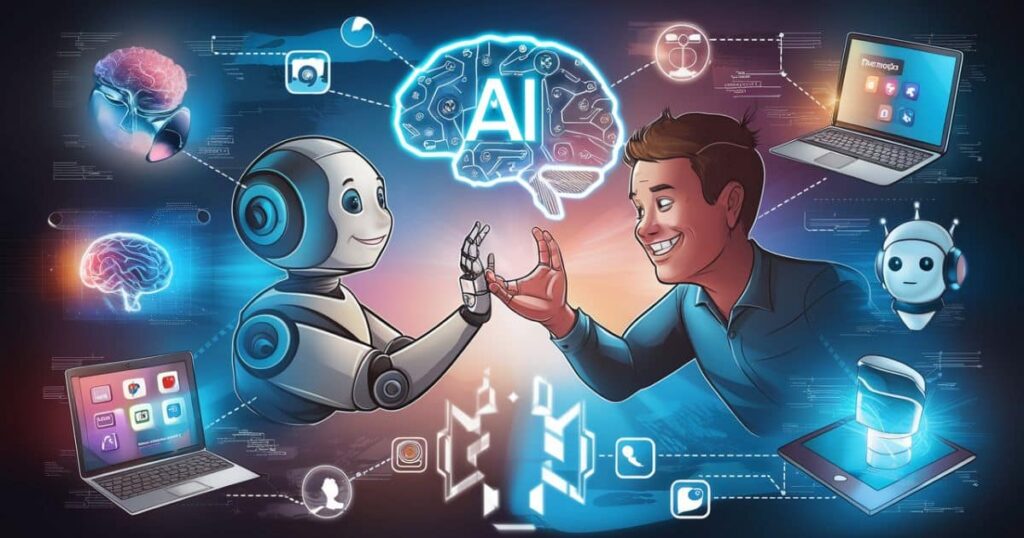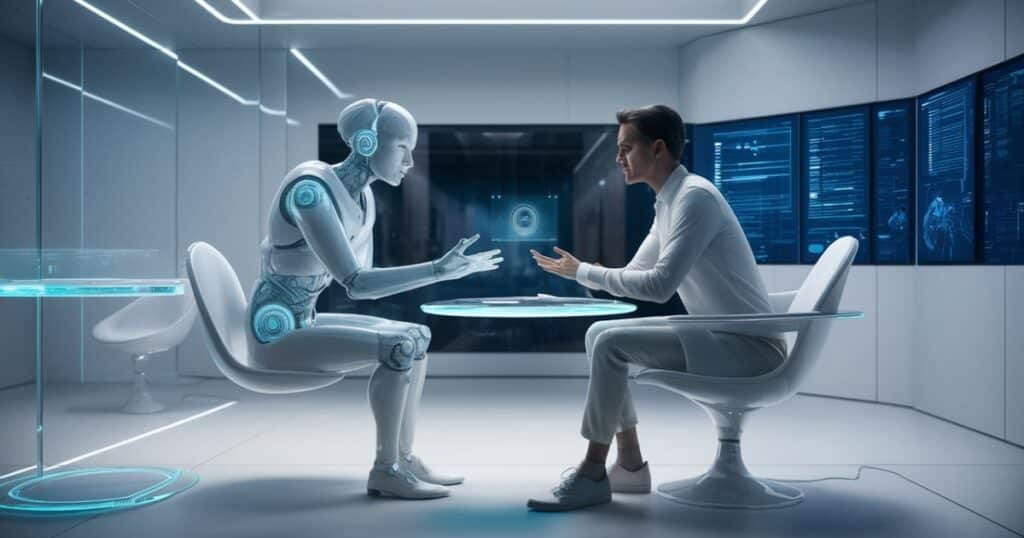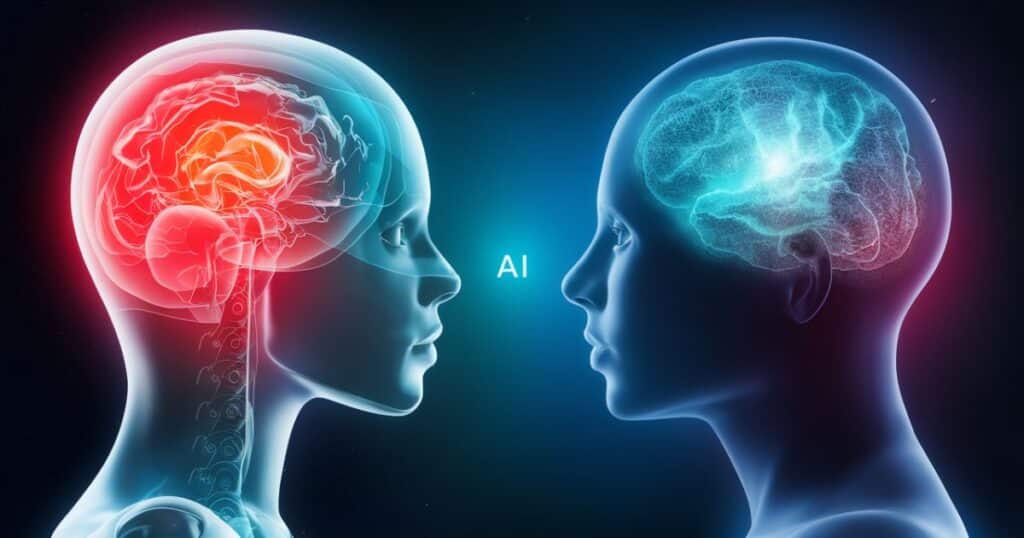In the age of rapid technological advancement, the lines between human and artificial intelligence (AI) communication are becoming increasingly blurred. The question “Am I talking to a human or AI?” is more relevant today than ever before.
With AI systems like chatbots, virtual assistants, and sophisticated conversational agents becoming more prevalent and advanced, understanding the differences and nuances of interacting with humans versus AI has become crucial.
This article delves into the history, development, and future implications of AI in human communication, exploring how it affects our daily lives and what we can expect moving forward.
The Evolution of AI in Communication
Early Beginnings
The concept of machines mimicking human conversation dates back to the mid-20th century. Alan Turing, a pioneering computer scientist, proposed the Turing Test in 1950 as a measure of a machine’s ability to exhibit intelligent behavior equivalent to, or indistinguishable from, that of a human. The idea was that if a human evaluator could not reliably distinguish between a human and a machine based on their responses, the machine could be considered intelligent.
Early attempts at creating conversational machines included programs like ELIZA, developed in the 1960s by Joseph Weizenbaum. ELIZA used simple pattern-matching techniques to simulate conversation, notably in its “DOCTOR” script which mimicked a Rogerian psychotherapist. Despite its rudimentary nature, ELIZA demonstrated the potential for computers to engage in seemingly human-like dialogue.
Advancements in AI
The following decades saw significant advancements in AI, particularly with the advent of machine learning and natural language processing (NLP). Machine learning enabled computers to learn from data and improve their performance over time, while NLP allowed them to understand and generate human language more effectively.
The development of neural networks and deep learning further revolutionized AI capabilities. Models like OpenAI’s GPT-3, released in 2020, showcased the ability to generate human-like text based on vast amounts of training data. These models could perform a wide range of language tasks, from translation to summarization, and even creative writing, blurring the line between human and machine-generated content.
Read More: Exploring Minecraft 1.20: What’s New and Exciting
Characteristics of Human vs. AI Communication
Language and Tone
One of the primary distinctions between human and AI communication lies in the use of language and tone. Humans use language with nuance, emotion, and cultural context. They can understand idioms, sarcasm, and humor, and can convey empathy and emotion in their responses.
AI, on the other hand, relies on patterns and data. While advanced models can generate text that appears human-like, they often lack true understanding and emotional depth. AI can mimic tone and style based on its training data but may struggle with context-specific nuances or novel situations that it hasn’t been explicitly trained on.
Consistency and Efficiency
AI excels in consistency and efficiency. Unlike humans, AI doesn’t get tired, make mistakes due to fatigue, or experience emotional fluctuations that affect communication. AI can handle repetitive tasks and large volumes of inquiries simultaneously, providing consistent responses every time.
Humans, while capable of empathy and nuanced understanding, can be inconsistent. Their performance can be affected by various factors such as mood, stress, and workload. However, this human element also brings creativity, innovation, and genuine emotional connection to interactions.
Learning and Adaptation
Humans learn and adapt based on experience, emotions, and social interactions. They can understand unspoken cues, read between the lines, and adapt their communication style to the audience. This adaptability is often informed by a lifetime of experiences and cultural understanding.
AI, however, learns from data. While machine learning models can adapt based on new data, their learning is bounded by the quality and quantity of that data. They lack the ability to genuinely understand or experience the world, making their adaptation more mechanical and less intuitive compared to humans.
The Role of AI in Modern Communication

Customer Service and Support
AI-powered chatbots and virtual assistants have become integral to customer service and support. They handle routine inquiries, provide information, and assist with common tasks, freeing up human agents to tackle more complex issues. This integration improves efficiency and response times, benefiting both businesses and customers.
However, the lack of genuine empathy and understanding in AI interactions can sometimes lead to customer frustration, especially in sensitive or complex situations. Striking the right balance between AI and human support remains a key challenge for businesses.
Personal Assistants and Everyday Use
Virtual assistants like Apple’s Siri, Amazon’s Alexa, and Google Assistant have become household names. These AI systems help users with tasks ranging from setting reminders and playing music to controlling smart home devices and providing weather updates. Their convenience and utility have made them an integral part of daily life.
While these assistants offer convenience, they also raise questions about privacy and data security. The data collected by these devices can provide insights into users’ habits and preferences, leading to concerns about how this information is used and protected.
Content Creation and Entertainment
AI is increasingly used in content creation and entertainment. From automated news articles and personalized recommendations on streaming platforms to AI-generated art and music, the influence of AI in creative fields is growing. AI can analyze user preferences and create content tailored to individual tastes, enhancing user experience.
However, the use of AI in creative industries also raises ethical questions about originality, authorship, and the value of human creativity. While AI can generate content, it lacks the emotional depth and experiential knowledge that human creators bring to their work.
Ethical and Societal Implications
Privacy and Surveillance
The widespread use of AI in communication and data collection poses significant privacy concerns. AI systems often require vast amounts of data to function effectively, raising questions about how this data is collected, stored, and used. There are concerns about surveillance, data breaches, and the potential misuse of personal information.
Ensuring transparency, data protection, and ethical use of AI are crucial to addressing these concerns. Policies and regulations need to evolve to keep pace with technological advancements and protect individuals’ privacy rights.
Bias and Fairness
AI systems are only as good as the data they are trained on. If the training data contains biases, the AI will likely reproduce and even amplify these biases. This can lead to unfair treatment and discrimination in various areas, including hiring, lending, and law enforcement.
Addressing bias in AI requires a concerted effort to ensure diverse and representative training data, as well as implementing fairness-aware algorithms. Continuous monitoring and evaluation of AI systems are necessary to mitigate bias and ensure fair outcomes.
The Future of Human-AI Interaction

As AI continues to advance, the future of human-AI interaction holds both promise and challenges. Here are some potential developments and considerations:
Enhanced Collaboration
AI and humans can complement each other, combining the strengths of both to achieve better outcomes. In fields like healthcare, education, and research, AI can assist with data analysis, diagnostics, and personalized learning, while humans provide critical thinking, empathy, and ethical judgment.
Improved Emotional Intelligence
Future AI systems may become better at understanding and responding to human emotions. Advances in affective computing aim to create AI that can recognize and respond to emotional cues, potentially improving the quality of interactions and making AI more relatable.
Ethical and Responsible AI
Ensuring that AI development and deployment are guided by ethical principles is crucial. This includes addressing issues of privacy, bias, and fairness, as well as promoting transparency and accountability in AI systems. Ethical AI practices will help build trust and ensure that AI benefits society as a whole.
Conclusion
The question “Am I talking to a human or AI?” reflects the profound impact that artificial intelligence has on modern communication. While AI systems have made significant strides in mimicking human conversation, they still lack the true understanding, empathy, and adaptability that humans possess.
As AI continues to evolve, it is essential to recognize and address the ethical and societal implications, ensuring that AI serves as a tool to enhance human capabilities rather than replace them. The future of human-AI interaction holds immense potential, and navigating this landscape thoughtfully and responsibly will be key to unlocking its benefits.






